Ambulance Types – What Are My Options

Do you ever wonder about the diverse types of ambulances utilized in emergency situations? Understanding the nuances between ambulance classifications can be crucial in ensuring proper medical care is provided swiftly and efficiently. From specialized vehicles designed for hazardous environments to advanced units equipped to handle critical care scenarios, each type plays a unique role in the realm of emergency medical services. Whether it is the intricacies of Type I, II, and III ambulances or the specialized equipment they carry, the world of ambulances is vast and essential in the healthcare landscape. Explore further to uncover the distinct features and roles of various ambulance types, shedding light on their critical importance in times of need. What Are The Available Ambulance Sizes What are the main sizes of ambulances available for emergency medical services? Ambulance configurations vary to cater to different needs. Type I and III ambulances feature square patient compartments mounted onto the chassis. Type I is truck-based, Type III is van-based, and Type II is a converted van with a raised roof. Ambulance customization options include specialized vehicles like isolation ambulances for hazardous conditions and bariatric ambulances for overweight patients. Safety features such as air filtration systems in isolation ambulances ensure patient and crew protection. Ambulance transportation is crucial for timely medical care, while fleet management optimizes resources for efficient service delivery. Understanding these distinctions aids in selecting the right ambulance for specific medical emergencies. Diverse Functions of Ambulances When considering the diverse functions of ambulances, it becomes evident that these emergency vehicles play crucial roles in providing specialized medical care for a range of conditions. Ambulances are equipped to follow isolation protocols when dealing with patients exposed to dangerous contaminants or contagious diseases. They excel in patient transport, swiftly moving individuals to medical facilities for urgent care. In emergency response situations, ambulances are the frontline providers of critical aid. They deliver specialized care to critically injured patients, functioning as mobile ICUs with advanced medical gear. Additionally, ambulances are vital in mass casualty incidents, efficiently managing multiple victims and providing necessary medical attention. CTG Medical’s Ambulance Services Exploring CTG Medical’s Ambulance Services reveals a network dedicated to providing comprehensive and efficient emergency medical transportation. Emergency response Patient transport Specialized care CTG Medical’s fleet is equipped with state-of-the-art medical equipment to ensure the delivery of specialized care to patients in need. Each ambulance is designed to cater to specific requirements, from advanced life support units to specialized vehicles for different medical conditions. Safety protocols are rigorously followed to guarantee the well-being of both patients and medical staff during transportation. Whether it is a critical medical emergency or a routine patient transfer, CTG Medical’s Ambulance Services prioritize efficiency, professionalism, and the highest standards of care. Importance of Medical Monitoring Equipment Medical monitoring equipment plays a vital role in tracking and evaluating patients’ health status in real time. It is crucial for patient care, as it continuously monitors vital signs such as heart rate, blood pressure, and oxygen saturation. This equipment enables remote monitoring, allowing healthcare providers to assess patients even during transport in ambulances. In emergency response situations, medical monitoring equipment provides essential data that guides decisions for critical care interventions. CTG Medical: Your Reliable Partner in Emergency Medical Services You have now delved into the wide-ranging realm of ambulance types, their varying capacities, and the integral role of medical monitoring equipment. These components, just like a well-coordinated machine, collaborate seamlessly to safeguard lives during emergencies. At CTG Medical, we understand the critical importance of these resources in healthcare. As your dependable partner, we are committed to providing top-notch emergency medical services, ensuring you have the right ambulances and medical equipment at your disposal when you need them.
Is it safe to fly after a C section

If you happen to be pondering the idea of flying post-C-section, there are important considerations you cannot overlook. The journey through the skies after undergoing this major surgery necessitates a thoughtful approach and a keen awareness of potential challenges that may arise. Understanding the timing for air travel, the precautions essential for your well-being, and ensuring a smooth voyage is paramount. Stay tuned to uncover the crucial insights that will assist you in making informed decisions and ensuring a safe, worry-free travel experience as you embark on this new phase of motherhood. What is a Cesarean Section If you have recently undergone a cesarean section, understanding the surgical procedure and its implications is essential for your recovery and well-being. The surgical procedure involves different incision types, like low transverse, low vertical, and high vertical, chosen based on factors like the baby’s position and pregnancy length. Healing scars from a C-section can be lengthy, with the typical incision length ranging from 4 to 6 inches. Challenges such as pain, cramps, bleeding, numbness, and infections may arise during recovery. Postpartum care requires rest, proper care, and support for a smooth healing process. Remember to monitor warning signs like heavy bleeding, intense pain, swelling, discharge, or fever post-surgery, and seek medical attention if any concerns arise. Identifying Risks and Warning Signs After undergoing a cesarean section, recognizing the potential risks and warning signs is crucial for your postoperative care and well-being. Post-surgery complications, such as infections, excessive bleeding, pain, and blood clots, can arise, requiring prompt attention. Be vigilant for warning signs like heavy bleeding, intense pain around incisions, chest pain, redness, swelling, discharge, or high fever, as these could indicate serious issues. The healing process after a C-section can present recovery challenges like pain, cramps, bleeding, numbness, and infections. Understanding surgical risks and promptly identifying warning signs are essential steps in ensuring a smooth recovery journey and optimal healing post-cesarean section. The C-Section Recovery Journey Navigating the recovery process post-C-section involves diligent care and attention to your body’s needs. Pain management is crucial during this time, with prescribed medications and gentle movements to alleviate discomfort. Scar healing requires patience; keep the incision area clean and dry, following medical advice for optimal recovery. Gradual reintroduction of physical activity helps rebuild strength, starting with light exercises as advised by your healthcare provider. Seek emotional support from loved ones or support groups to cope with the emotional aspects of recovery. Breastfeeding challenges may arise, but you can overcome them with patience, guidance from lactation consultants, and proper positioning techniques. Guidelines for Air Travel Post C-Section Considering the recent C-section surgery, planning your air travel requires careful consideration and adherence to specific guidelines for a safe journey. Travel restrictions post-C-section typically recommend waiting 6-8 weeks before flying, with medical clearance for high-risk cases. Monitoring your healing progress is crucial, ensuring stitches are properly sealed and any complications are resolved before flying. Compression stockings can help reduce the risk of blood clots during the flight. Remember to stay hydrated by drinking plenty of water, especially in the dry cabin environment. Be mindful of cabin pressure changes that can affect your body post-surgery. Following these guidelines and taking necessary precautions will help you have a smoother and safer air travel experience after a C-section. Potential Concerns of Flying Post-Surgery Flying after a C-section may pose potential concerns that require careful consideration and preparation. To minimize swelling, ensure you move around the cabin regularly and wear compression socks. Proper stitch care is vital; avoid tight clothing that may rub against the incision, and follow your healthcare provider’s instructions for wound care. Reduce blood clot risks by staying hydrated, stretching your legs, and possibly taking prescribed blood thinners. Manage dehydration by drinking plenty of water and avoiding alcohol and caffeine. To prevent barotrauma, swallow frequently during changes in cabin pressure and consider using earplugs or specialized ear pressure-regulating devices. Prioritize your well-being by addressing these concerns before and during your flight. Consulting Doctors Before Air Travel Before your upcoming air travel following a caesarean section, make sure to schedule consultations with your healthcare providers to address any concerns or risks associated with flying post-surgery. Ensure effective pain management strategies are in place. Discuss prevention measures for potential complications during the flight. Review emergency response plans in case of unforeseen medical issues. Seek guidance on infant care specific to air travel. Obtain medical clearance to fly safely post-surgery. Preparing for the Flight After C-Section When preparing for your flight after a C-section, ensure you have all necessary medical documentation and supplies. Postpartum care is vital; pack any medications, wound care essentials, and your doctor’s contact information. Be aware of any travel restrictions based on your specific recovery progress, and consult your healthcare provider if unsure. Consider wearing compression stockings to reduce the risk of blood clots during the flight. Take comma out after the word progress Prioritize pain management by having pain relief medication readily available. Plan for in-flight comfort by choosing loose, breathable clothing and bringing a pillow for support. Remember to stay hydrated and walk around periodically to promote circulation. Take precautions to make your journey as smooth as possible. Exploring Medical Escort Services Ensure your post-C-section journey is smooth and secure by considering the comprehensive care medical escort services provide. Medical escort services offer specialized assistance tailored to your post-surgery needs, ensuring your well-being and comfort throughout the flight. Post-surgery assistance: Dedicated support for your specific post-C-section requirements. Medical escorting options: Skilled professionals accompany you for a safe journey. Travel clearance: Ensuring all necessary medical approvals are obtained for your flight. Healing support: Continuous care and attention to aid in your recovery process. Flight safety: Prioritizing your safety and well-being during air travel. Secure Your Health with CTG Medical’s Emergency Services Now that you have understood the intricacies of air travel after a C-section remember to prioritize your health and heed your doctor’s advice. Additionally, with CTG Medical by your side, you can be confident in receiving
How to travel safely after an angioplasty

Have you ever wondered about the specific guidelines and precautions you should follow when considering air travel after undergoing an angioplasty procedure? The intricacies of flying post-angioplasty may not be common knowledge, but they are essential for your well-being. As you contemplate your next journey, understanding how to navigate air travel safely and comfortably following this cardiac procedure is paramount. Stay tuned to uncover the key insights that will aid you in making informed decisions and ensuring a smooth transition to the skies after angioplasty. Understanding Angioplasty Procedure In angioplasty, narrowed or blocked blood vessels, particularly in coronary arteries, are widened following a specialized procedure using a balloon catheter to restore optimal blood flow and improve organ function. During this procedure, the balloon catheter is inserted into the blocked artery and inflated to push the plaque against the artery walls, reopening the vessel for better blood flow. After angioplasty, the recovery process involves monitoring for any complications like bleeding or allergic reactions. Artery blockages are a common reason for performing angioplasty to prevent serious conditions like heart attacks. The balloon catheter plays a crucial role in this process by physically opening the narrowed arteries. Ultimately, angioplasty aims to enhance organ function by ensuring adequate blood supply to vital tissues. Post-Angioplasty Travel Precautions After undergoing angioplasty, adhering to specific travel precautions is crucial to ensure your safety and well-being. Following your healing timeline is essential before considering air travel. Ensure proper medication management during your journey and carry necessary prescriptions. Consider obtaining travel insurance that covers any medical emergencies related to your condition. Adhere to activity restrictions recommended by your healthcare provider to prevent complications. Schedule follow-up care appointments to monitor your recovery progress. Prioritize your health by being cautious and prepared for any potential challenges that may arise during your post-angioplasty travels. Potential In-Flight Complications Following your angioplasty and the necessary travel precautions, understanding the potential in-flight complications is crucial for your safety and well-being during air travel. Changes in cabin pressure can impact artery healing, potentially leading to blood clots. Additionally, fluctuations in cabin pressure may affect your heart rate and heart rhythm, especially if you have preexisting conditions. It is essential to stay hydrated, move around periodically, and follow any recommendations from your healthcare provider to mitigate these risks. Being aware of these potential complications enables you to take proactive measures to ensure a smooth and safe flight after angioplasty. Remember to communicate any concerns with the airline staff and seek medical attention if you experience any concerning symptoms during your journey. Flying Options Post-Angioplasty Consider exploring medical escort flights or air ambulance services for safe, supported air travel post-angioplasty. The healing process after angioplasty requires special attention, and flight restrictions may apply during the initial 7-14 days due to vulnerable arteries. Your recovery timeline and medical clearance will determine when it is safe to fly. These services offer tailored travel accommodations, ensuring you receive the necessary support and care during your journey. Medical escort flights provide skilled professionals to monitor your vital signs and manage medications, while air ambulance services offer a comfortable experience with specialized medical equipment and critical care experts. Prioritize your well-being by choosing these safe flying options post-angioplasty. Benefits of Medical Escort Flights Explore the advantages of opting for medical escort flights for safe and supported air travel post-angioplasty. Medical escort flights offer vital benefits such as medical monitoring, travel assistance, care coordination, emergency response, and vital sign monitoring. Skilled medical professionals accompany you throughout the journey, ensuring continuous monitoring of your health status. In case of any complications or emergencies, they are equipped to provide immediate medical assistance. The team assists with medication management, ensuring you adhere to your prescribed regimen even while traveling. Additionally, the care coordination ensures a seamless transition from the hospital to the aircraft and vice versa, prioritizing your well-being and comfort throughout the flight. Choosing a medical escort flight provides a tailored and secure travel experience post-angioplasty. Travel Safety Reminders Following Angioplasties To ensure a high standard of care in your post-angioplasty travel, prioritize medical guidance and support. Adhere to healing timelines and recovery guidelines set by your healthcare provider. Respect travel restrictions, such as avoiding flying during the initial 7-14 days post-procedure to protect healing arteries. Regularly monitor your progress and communicate any concerns promptly to your medical team. Ensure proper medication management, including taking prescribed medications as directed and carrying necessary supplies during travel. Affiliate Partnerships for Patient Support Partner with trusted medical organizations for enhanced patient support and care post-angioplasty. Travel Assistance: Collaborate with medical partners to provide specialized travel assistance for post-angioplasty patients, ensuring safe and comfortable journeys. Patient Care: Create personalized care plans in conjunction with medical organizations to address individual patient needs during travel, focusing on health and well-being. Support Services: Offer a range of support services in partnership with medical experts to guarantee comprehensive care for patients post-angioplasty, including medical escorts and in-flight medical assistance. CTG Medical: Your Trusted Partner for Emergency Medical Services As you prepare for your air travel following an angioplasty, your health and well-being should be your main focus. With meticulous planning and an understanding of possible risks, you can start your journey confidently. Whether you need a medical escort flight or are considering other safe flying alternatives, specialized care is accessible to meet your travel requirements. Stay informed, stay ready, and fly with certainty. CTG Medical is dedicated to providing top-notch emergency medical services to ensure your safety and comfort during your travels. With our skilled medical staff and state-of-the-art facilities, we aim to make your journey as smooth as possible. Trust CTG Medical to support your health needs and help you travel with peace of mind.
